by Tom Gaylord
Writing as B.B. Pelletier
This report covers:
- The Design an Airgun contest
- Air gun?
- How to enter
- I lost one entry
- The Godfather’s Gold Gun drawing˜
- On to today’s report on cant
- Canting is not part of scope mounting
- What is cant?
- The cant test
- What cant does
- Things that affect cant
- What canting can do
- When precision is a must
- Consistency
- How to eliminate cant
- High scopes
- Where the level goes
- Summary
The Design an Airgun contest
Apparently it took a while for many of you to realize this Design an Airgun contest was happening, so I’m extending the deadline to Friday, October 16. I’m challenging you to design an airgun that we readers can build!
I’m guessing it will be a BB gun, but it doesn’t have to be. It doesn’t even have to be a gun, as long as it shoots something at a target. If it is a gun I’m guessing it will be a smoothbore, but again, it doesn’t have to be.
Air gun?
When I say build an airgun, it doesn’t have to work with compressed air. The Daisy 179 pistol is considered an airgun, but in reality it is a catapult gun. And spring-piston guns don’t have compressed air until the instant they fire.
How to enter
You can enter by writing your design as a comment. Attaching pictures helps me a lot. One reader has already entered by submitting a You Tube video. Or you can email me at blogger@pyramydair.com. I’m wanting to show all of you how the winning design works in a special report, so any help you can give me is appreciated.
I lost one entry
To the reader who submitted two designs with photos to me via email several weeks ago — please send them again. I have lost them. I remember making a file of your entire submission, but after three days of searching I cannot find it. You were the first person to submit an entry and you explained it well enough that people could follow along and build it themselves.
The prize for the winning entry is the odd gun I have shown you many times. I called it the American Zimmerstutzen. I have to limit the contest to US readers because of the problems of shipping the prize.
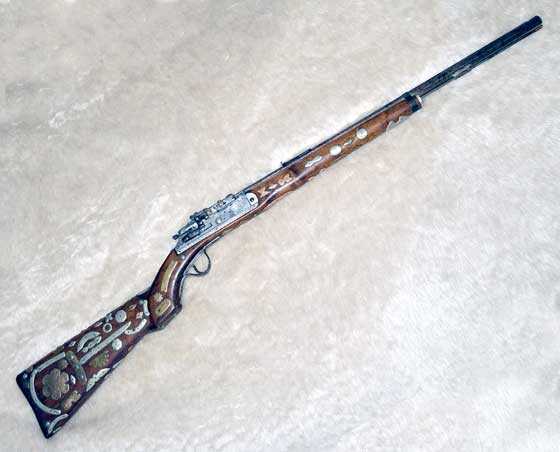
This is the prize for the best airgun we readers can make. It’s an intricate homemade weapon that I think is the perfect prize for this contest!
The Godfather’s Gold Gun drawing
The other contest for the Goldfather’s Gold Gun starts today. That is an Ataman AP16 air pistol that I built up using the new Pyramyd AIR “Build Your Own Custom Airgun” software.
One day in October I will choose a winner from all the readers who comment. Whether you comment once or many times makes no difference. Your comment enters you into the drawing for this air pistol. I will not announce the day I select until the month is over. Once again, this is limited to US readers.
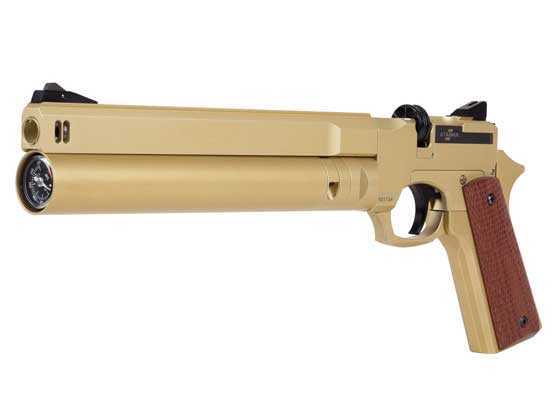
The Godfather’s Gold Gun will belong to one lucky blog reader after October is over.
On to today’s report on cant
Today we look at cant, as in tipping the rifle and scope while shooting. I’m going to sum up today’s report in a single word — consistency. Because that is what we are after. The report will explain.
Canting is not part of scope mounting
We are concerned with canting on every shot we take. It’s not something that gets addressed while mounting a scope — BUT!!!! So many shooters associate canting with scope mounting that we need to discuss it now. Part 2 was the last part of scope mounting, per se.
What is cant?
Cant means a prominent angle or tilting, as defined by dictionary.com. But in shooting it means something far more devious. Yes, it is a tilt, but it is also an inconsistent tilt, and it’s that inconsistency that creates the problem.
The cant test
When I wrote The Airgun Letter I did a cant test with my subscribers. I asked them to shoot three groups of 10 shots at 50 yards. One group was to be a regular group where they were to zero their scopes to hit the center of the target. I sent out special targets that had bolded lines for the shooters to cover with their reticles. One set of lines was tilted 20 degrees to the left, one set was aligned correctly and one set was tilted 20 degree to the right. If they covered the lines with their reticle they would shoot one group straight, a second group canted 20 degrees to the left and a third group canted 20 degrees to the right.
The results of the test were dramatic and all were the same. Everyone was sighted to hit the center of the target at 50 yards. When they canted 20 degrees to the left their 10-shot group landed low and to the left. When they shot straight on their groups hit the center of the target. When they canted 20 degrees to the right their groups landed low and to the right. Let’s look at the results from four shooters.
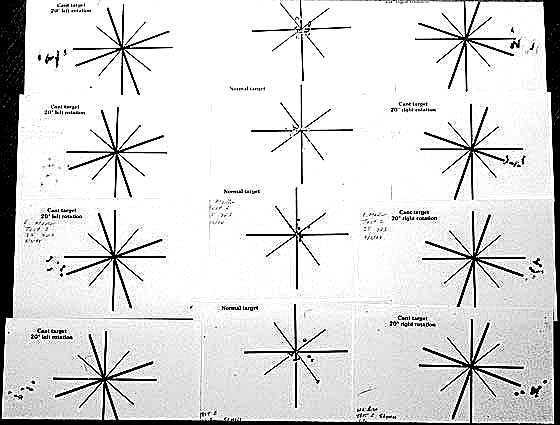
These are the results of 4 different shooters shooting 10 shots at each of three targets at 50 yards. Targets on the left were shot with the scope canted 20 degrees to the left. Same on the right. Center targets were shot with the scope level. We used the heavy lines on each target to align our reticle.
What cant does
When a scope cants away from the orientation at which it was sighted-in (notice, I did not say from where it was level), the pellet impacts in the same direction as the cant. A right cant produces a pellet impact that’s more to the right than it should be. The pellet also drops away from level at the impact distance. The next drawing shows this very clearly.
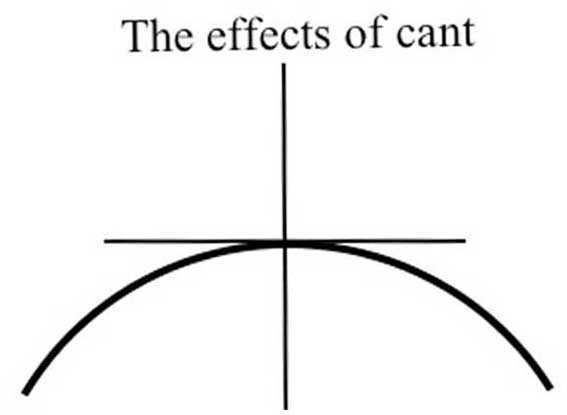
The heavy curved line represents where pellet will impact if the rifle is canted from its sight-in position. The farther the distance from the shooter to the target, the more pronounced the curve.
Things that affect cant
Distance — the farther out you go the more affect cant will have.
Height of scope — The higher the scope is (farther from the bore axis) the more affect cant has.
Velocity — the higher the velocity the less affect cant has. If you look at the picture of the cant test you’ll see that some pellets didn’t drop as far as others. That was due to their velocity.
Discussion
I made this test exaggerated to show the effects of cant dramatically. Most shooters would never cant by as much as 5 degrees, let alone 20. There are, however, some things outside the shooter’s control that will also enter into the discussion.
When I worked at Frontier Village amusement park in the 1960s, we had an attraction called El Sito Mysterio. It was patterned after an attraction in the nearby Santa Cruz mountains called the Mystery Spot, where gravity was supposed to be all confused. El Sito at the Village was a small shack that had several interesting illusions. My favorite was the bowling ball that rolled uphill. I worked there and gave the pitch and even I was fooled! So terrain and visual cues can fool anyone into making a mistake.
What canting can do
Even a one degree cant has an effect on shot placement. Let’s now look at two groups that were fired with and without cant.
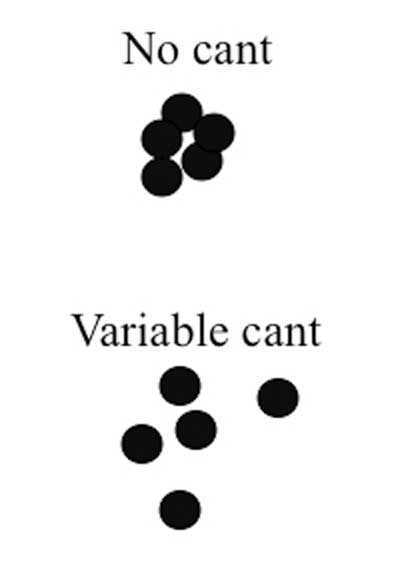
This drawing is representative of how cant affects a group. This is why it isn’t that noticeable. It just looks like poor accuracy. It’s easier to see at 50 yards than at 10.
When precision is a must
Cant doesn’t always matter. To a hunter shooting in the woods, a fast rifle with a quick second shot is more important. The squirrel doesn’t care if the pellet lands 1/4-inch from the intended impact point. But to a varmint hunter busting prairie dogs at 300 yards, cant is very important.
Field target shooters are quite aware of the effects of cant because when they hit their target one pellet’s diameter off their intended impact point they may hit the side of the kill zone and lock the target in the upright position. Canting costs them points, and they are already fighting their own body’s stability. They don’t need a second problem.
Consistency
I said at the start of this report that consistency was the solution to canting. Now I’ll explain why that is. When you shoot, the pellet leaves the muzzle for the target — hopefully with the muzzle in the same place each time. By canting or tilting your gun, you move the scope off target and then you have to move the gun to get it back on. When you do, the muzzle is in a slightly different place than before. It could be less than one-tenth-inch or 2.54 mm, but it is different and, if the gun is accurate, the pellet will fly to a different place. And that does affect accuracy in a most insidious way, as you see in the group above.
How to eliminate cant
Cant is eliminated by leveling the rifle before each shot. This is done with an accessory called a scope level. It doesn’t matter where the reticle is — so long as it is always in the same place when the rifle fires. If the rifle is accurate and if it shoots to the same place every time, the group will be small and exactly where the shooter wants it.
Let me show you a short test I did that shows the importance of this. The test is straightforward. First, I seasoned the bore with several shots. Then, I fired a group of 10 shots at 25 yards with the Whiscombe rifle canted to the right for 5 shots and to the left for 5 shots. The cant was controlled by the position of the bubble in the level, and I stopped tilting the rifle the moment the bubble came to the end of its travel. Obviously, there’s some error in this, as the bubble level is not a precision instrument, but I think you’ll get the idea.
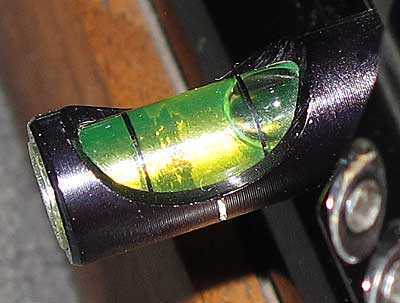
The Whiscombe was canted to the left until the bubble came to the end of its travel on the right side, as shown above. Five shots were fired at the target with the crosshairs on the center of the bull at 25 yards.
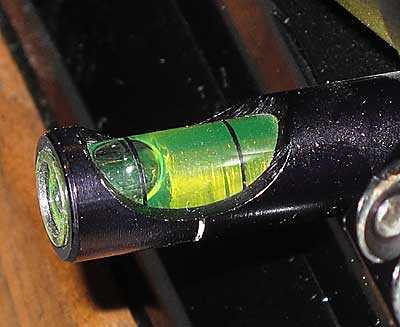
The Whiscombe was then canted to the right until the bubble came to a stop on the left side, as shown above. Five more shots were fired at the same target, just as before.
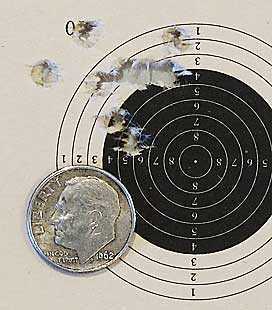
And this is the result. It’s impossible to tell that canting opened this group.
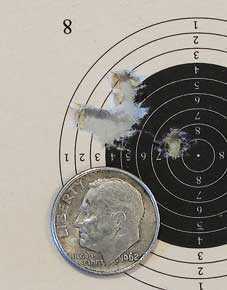
Same rifle, same distance, same pellet, only this time the rifle was leveled for each shot.
High scopes
Scopes that are mounted high above the boreline are influenced by cant the most. This is why many shooters want their scopes mounted as low as possible. Repeaters with magazines that stick out above the receiver mitigate against this, of course.
Where the level goes
Mount the level on the air rifle where it best fits how you shoot. When I use a separate bubble level I mount it sticking out to the left side of the rifle. Before each shot I look at the bubble and make any corrections that are necessary. But best of all is when the bubble is built right into the scope — like it is on the UTG Bubble Leveler scope! Then I don’t have to take my eye off the target.
Summary
Canting isn’t a part of mounting a scope, but if the scope is mounted correctly then the rifle can be leveled for each shot afterward with assurance that it will do its best.
We are still not finished with this series. The next report will be about optically centering the scope and centering the reticle mechanically. I hope you are getting something out of this.


B.B.,
Probably the most prominent high scope mounting air rifle the come to my mind is the product line of AirForce where the design requires a high mount. Does this problem also come up with the Air Arms Tx200?
Siraniko
PS: Section How to eliminate cant 1st paragraph 2nd sentence, “This is done with an ac c essory (accessory) called a scope level.
Siraniko,
Thank you. I fixed it.
BB
just logging in for the drawing…
Siraniko,
Not as pronounced as in the AirForce design. One of the issues that causes high mounting is the design of the cheek rest. The higher the cheek rest in relation to the bore, the higher the mount. This will vary from person to person also.
There have been many aftermarket solutions to the high scope design on the AirForce platform, some better than others. I am so glad that AirForce finally developed a side cocker other than the Edge. With the cocking mechanism on the side, the mounting rail can be closer to the bore. They should refine this design for all of their models.
Of course you still have the issue of the bottle diameter. A smaller diameter bottle as on the TalonP helps. A small diameter reservoir as on the Edge works great, but both of these reduce shot count and some people freak out if they cannot get one hundred forty-seven shots per fill.
A canted / angled bottle interface also helps. I have seen Z shaped offset bottle interfaces that work great. I have seen modified AirForce frames using these methods in conjunction with a side cocking modification where that high rail is cut off and a Picitinny rail is mounted in its place, bringing the scope way down closer to the bore.
AirForce airguns are a tinker’s dream come true.
One of the reasons I ended up with a Condor SS is being able to tinker with it.
Also, the height of the scope above the bore is determined by the size of the objective lens. I had to go with mid-height rings in order for the 44mm objective to clear the barrel on my Urban.
B.B.
I always think it is cute that cant=can’t, lol…
Magic Mountain is still there and still confounding people.
What is the secret?
-Yogi
Yogi,
The secret is one of perception. Make the place where these things are seen a place where you can’t “get your bearings.”
BB
BB
Illusions, optical and others too, abound all around us. Look at a good book or video on illusions/perception. You may start to wonder what is real and what isn’t.
Liking this series and look forward to more.
Deck
BB,
Lots of perception problems are compounded by lowlight or darkness! In flying they can be fatal like in John Kennedy Jr. crashing in a death spiral because his instrument/night VFR (Visual Flight Rules) flying skills were as bad as Teddy’s driving skills on small bridges!
https://www.aviation.govt.nz/licensing-and-certification/pilots/flight-training/flight-instructor-guide/night-flying/
Optical illusions are everywhere and they can lead to BAD outcomes.
CANT is bad for our target scores or in long range hunting for the animals! After years of using levels on all my scoped rifles i find i eventually get my position by nerve and muscle memory…unless i drink to much caffinated beverages before shooting.
shootski
shootski
I remember as a kid in the 1970’s a place in California, I don’t remember where, that had a shack and inside was water flowing uphill for about 6’ in a small wooden trough.
Really cool illusion.
John Carlisle
B.B.
Excellent explanation of the topic. In the section, ‘Consistency’, a tenth of an inch would equal 2.54 mm or .254 cm.
Bruce
Bruce,
Thanks. I fixed it.
BB
BB,
Another fine installment in the series. Looking forwards to optical/mechanical centering installment.
Chris
Me too, Chris.
I never understood why it it not ok to have the scope in the last 1/3 of adjustment-up or down, right or left-when you shoot. But it is “good practice” to yank the scope all the way to zero-ok maybe only 3-5-and then yank it all the way in the opposite direction? I figure this would mess up the internal tube springs even more. Hopefully B.B. will clarify…
Stay safe,
-Yogi
Good morning all,
I have the bubble level scope that BB mentioned (bought at his recommendation), and while I can see the level looking through the scope, it is very subtle. I have to look at the bottom to see it, it is more of a shadow that moves side to side than an actual level like what BB pictured above, or the illustration on Pyramyd AIR (included below).
I don’t mind that, I was concerned about how much of the sight picture it might cover up when I ordered it, but I do wish it was a little bit more obvious than what it actually turned out to be.
It really is handy to have the level in the scope though.
CB
I have the same issue with my bubble-leveler scope. Extremely hard to see the bubble. Not that practical. Because of it, I wondered if they’re all like this or if mine is defective.
Glenn
Glenn,
They are all like that. The secret is to let a little light in through the objective. Then the bubble brightens up.
B.B.
BB
If that’s the case maybe they should have the bubble illuminated.
You think that would help?
Maybe a revised edition is in order.
GF1,
That illuminated bubble might work — if it can be done.
BB
BB
Well that’s up to the smarter people than me that design that stuff. 🙂
B.B.,
With the improvements in fiber optic production I don’t see why the engineers can’t incorporate one into the tube.
Siraniko
Siraniko,
Hako of Japan was doing that for their reticles in the 1970s.
BB
BB
Optical centering never enters into mounting or adjusting my external adjustment Bausch & Lomb Balvar 8A. Travel of the tapered spools and attachment spring, however, can limit the adjustment. Cant is still there, of course.
Jumpin
B.B.,
I’m looking forward to the next parts of this series.
My exposure to scopes is limited to rifles that had scopes mounted by others. My rifles were open sights only. Scopes cost too much for a young buck to consider. Now I have a couple of “cheapies” and while they are not close to excellent, they do help old eyes. As with anything, experience counts and it’s better to learn from other’s experience than to re-invent the wheel every time. Hoping to apply your teaching to improving my tools to the best that they can be.
Thanks,
Dan
Appreciate the excellent information and tips in this scope series; more to scoping/sighting than meets the eye, for sure.
BB
Yep you got it. Good report.
BB have you ever done a single post on internally how a scope works? Not optically but how the cross hairs actually adjust. You talked about it a bit at the beginning of this series and you have discussed it from time to time in single articles.
Slevane,
That might be a good basic report.
B.B.
B.B.,
I’ll second Slevane on that request; I think that would be a great and very helpful report.
And as for this set of reports, and your statement, “I hope you are getting something out of this.”
The answer to that is an emphatic “Yes!’ Thank you.
I particularly like the canted versus leveled group…very interesting.
Looking forward to the rest of this series,
dave
BB, I like how the bubble level gives the user usefull information, but now I want a scope with a computer in it.
I often want to change my pellet, bullet choice, but dont because i would need to rezero the scope. Wouldn’t it be nice to have savable ballistic maps, for each pellet/bullet, ( based on other data like velocity ,B\C, barrel length) with a near zero and a far zero and a mid point. Just scroll to your ammo type, and the reticle aimpoints change to correctly match the changing balistics of a given projectile. I suppose a smart phone would be part of the process.
The bubble would read degrees of cant. Part of the issue for me is keeping trac of all the possible aim points on a given reticle, sometimes it’s not easy to distinguish between the 4th hold over mildot, and the third one, so if they were defined by colors, that might be nice and easy to see. I like the zimmerstutzen stock, I think I would like a nice wood stock on one of my Crosmans that is decorated and embellished like a Cochise war trophy rifle.
Rob
Rob, this sounds like a great idea – with the caveat that it’s another thing to keep powered/charged.
Rob,
Sig makes such a scope right now. And it works with a smart phone.
BB
That is great news, I am very curious now, because when I took two 85(?) yd pigeon shost with my .25 Mrod, it was stressfull because I wasn’t 100% sure which mildot I should use, and also needing to count them, and then get out of the scope tube, check my fov, then go back for my shot, would be nice having my mildot stand out more. Nailed 2 in a row @ 3 mils high, with JSB Kings flying at 940 fps. Way better than my R10 could hope to do. I think optics are a big deal. For precision shooting I would even have a trailer hitch style knob on the barrel, and a receiver on the gun rest, for repeatability. Thats pretty far down the rabbit hole I think.
Thanks,
R
Rob, Check out ATN scopes. – Don
/product/atn-x-sight-4k-3-14x-pro-edition-smart-day-night-hunting-rifle-scope?a=8651
Don, Thats tempting.
https://www.opticsplanet.com/reviews/reviews-sig-sauer-sierra3bdx-6-5-20x52mm-riflescope-30mm-tube-bdx-r1-digital-ballistic-r.html
But the laser range finder is extra.
R
Also, I like the image capture, at night for sure, of the ATN, it has infra red. For daylight, Sig 6.5 x20 with blue tooth? If it had IR sensor, then a IR lamp is all that is needed, f night use maybe?. I think a trigger housing located control, just a small trac pad, to select/range targets in the scopes fov with Sig laser range finder light. I wonder if it’s light can be sent out as a flood light?
They both have pluses and minuses, just don’t really know but for day light use, the Sig is interesting to me. In cases of one or the other, get both, send one back?
Rob
Rob,
That ATN has a lot of features for hunters. It will find the range based on 2 spots on the target a known height apart, for use by the internal ballistic calculator. But using the coupled optional laser rangefinder seems easier. – Don
https://www.atncorp.com/x-sight4k-pro-day-night-rifle-scope-5-20x
Great stuff B.B.!
The “in receiver”, low magazine of the HW 100 and the low mounted scope are two of the many things that make that Weihrauch my favorite PCP!
I found cant to be a concern with the high scope mount on the FX Impact, that and I am shooting at much longer ranges than I typically used to.
So, how critical is it to mount the scope with zero cant (the crosshairs bisect the bore) relative to the bore?
Read that people say that it makes no difference as long as you hold the rifle consistently. To me it would seem that if the crosshairs were not at zero cant then the scope would be zeroed on only at a specific distance and the POI would shift as the distance changed. Unless mounted with zero cant, holdover using the vertical crosshair for reference or dialing the scope would result in a change of POI .
Hank
I too have heard people say that having the scope leveled when mounted is not important, as long as we are consistent in how we hold it.
I will say that I disagree with that view, because if there is any cant in the rifle when we shoot, then that cant will translate into different degrees of left/right shift at different distances. I feel the only way to avoid that is to get the scope as centered as we can over the action, and then have the reticle as vertical as possible while in that position. This, coupled with striving to keep the rifle vertical (via a bubble level) will reduce that left/right impact shift greatly.
I agree that we can never make it perfect, but getting it as close as we can makes things better.
Alan
Agree totally Alan,
I tend to take things to the extremes – scope mounting is one of those things.
I usually set up a plumb-bob in front of a mirror (maximum magnification and adjust out the parallax) to get the vertical crosshair exactly vertical and centered on the bore. That way, if the crosshairs look “off” I know I am not holding the rifle level and will take steps to correct my hold or the stock to fix that.
Hank
Alan
Would the same apply if the scope wasn’t exactly level with the action, but the reticle was level when taking the shot?
The relationship between the bore and scope would remain constant so I don’t see how it would affect shot placement
I think it always matters. Here is why I think that is the case . . .
I like to think of this from the perspective of basic geometry, first as two lines, and then as two planes. The two lines are the straight lines that emanate first from the barrel – the ideal flight line of the pellet, assuming there was no drop from gravity or wind drift – and the second being the optical line of the scope. The two planes are derived from these lines, with the first being what I will call “the barrel plane”, and it is defined as that first line out the barrel and down to the ground via gravity (because that is the arc the pellet will fly in, regardless of any relationship to the scope – hold the gun 90 degrees to the ground and the pellet will leave the gun and still arc to the ground). The second plane would be the from the center of the scope’s line of sight through the axis of the vertical reticle line – I call this the “scope vertical plane” as it is the one in which the scope moves with vertical adjustment (of course there is a horizontal plane too).
In the ideal situation, the two planes would be one and the same – and as we know any two lines on that plane would have to either intersect or be parallel. Zeroing the scope at any given range would would be tuning the intercept point. If this ideal were met, there would never be any left/right variance (other than wind or spin drift) from this plane when shooting at different distances.
But if the two planes are not the same, then even when we zero the scope to the POI, we are faced with an absolute requirement that there will be some amount of left/right variance when we shoot at a different distance from the one we are zeroed at – and thus to re-zero we need to not only adjust vertically but also laterally.
The only way to get to the ideal is to work to have the scope in the same vertical plane as the barrel, and this means having the gun as “level” as we can get it side to side, and then leveling the reticle in the scope too. And if we really want things to be as dead on as possible, we have to make sure that the axis of the scope points in the same direction as the barrel too – for that we really need fully adjustable rings, and using them right is a whole other topic. Of course we also need to strive to hold the gun this way when shooting to avoid the impact of cant.
But if the gun is set up with an amount of cant in the scope, then even if we hold it perfectly the same way every time, we will get lateral shifts at different distances because the planes will not be the same (nor parallel either, which is not a bad situation if the offset is small).
Short of all that, we do want to do the best we can at getting things level and parallel (sometimes flipping scope rings around can help with the parallel issues), and that will at least minimize the lateral shift of the POI at distance – at least until the wind blow!
Alan
Alan
Excellent description. I think I get it now. Be interesting to see a real world demonstration
Alan,
You know — I didn’t address that, and you’re right. I’ll stick it in the next report. Thanks,
BB
Would you see an effect from cant on open sights too? Or are they too small due to being close to the bore? Looking forward to the next part RE: centering.
Whetor,
Yes, the effect of cant is independent of the aiming device, could be red-dot or iron sights too. The issue is how close to vertical is a line connecting the center of the bore and the aiming point.
Of course, as you suggest, the closer the aiming point to the center of the borehole the lesser the impact that a small tilt can produce. So low mounted sights are less sensitive to cant.
Henry
whetor,
I know that canting peep sights can be a problem, so I suppose open sights could be, as well. But like you said — open sights are too close to the bore to matter that much.
BB
BB,
Canting is a problem, irrespective of a sight’s position in relation to the bore, because of the bullet flight path. If the bullet traveled in an absolutely straight line, it wouldn’t matter how canted the sight was, but due to the parabolic path of the projectile, the sight is adjusted to allow for that. When you introduce a cant to the sight, gravity acts in the same direction (down) but the path of the projectile is at an angle from vertical, so lower and to the right, or left. If you would cant the sights all the way to 180 degrees (inverted), then your shots would be on center with the bull but very low.
An interesting thought exercise in regarding your change in frame of reference.
Bill
BB, what ’bout my design?
Fish
Post some more details. That looks like something even I could build!
Ade,
i’ve posted more details, pls take a look at my reply when/if u have time.
why would you say even? u can do anything you want.
yes, something cheap, low powered, and everybody can build was my goal.
if BB gives me the ok, concept wise, i’ll put more time into making it user friendly. cotton swabs fly!
Fish,
What am I doing?
BB
BB,
my balloon / cotton swab design for the contest. One of the last comments on yesterday’s report. is it a go?
Fish,
Yes it is.
BB
🙂
Fish,
You could come up with a “magnum” load. Maybe?,… use one of them long shanked wood stick ones like they stick up your nose (and to the back of your brain),… for Covid test? 😉
Chris
chris,
thought about that; it even tingled my brain a bit. 🙂 but too heavy for it to work. finding the optimum load weight and barrel length were the key for success.
I’m thinking bout using a valve maybe, instead of a peg, but the air has to be released fast. so won’t work either. i will improve the peg design.
I just don’t want to spend more time on it if BB doesn’t want it in the contest.
chris,
long story short, it shoots the cotton swabs like charm. I just don’t know if my entry was accepted by BB.
Fish,
Pretty safe to say,…………. YOUR IN! 🙂
Chris
Whetor
It would likely be almost unnoticeable on a rifle with iron sites because the line of sight is so close to the line of the bore,, but there would be a small variant. To understand why cant affect shot placement, you have to remember how the pellet or bullet travels from barrel to target. It is not a straight line because gravity drags it back down. So the barrel on a properly scoped and held barrel will point upward as compared to the line of sight through the sights. Gravity pulls the projectile straight down.
An example even more extreme than BBs would be to lay the rifle on it’s side so that the sight line and the barrel are now level with each other. When you fire the weapon, gravity is now acting on the projectile pulling it straight down and away from the sight line.
I hope I made sense without going into vector analysis (which is not my forte, anyway)
Ed
Edlee,
That is exactly why earlier in this series I suggested that after fixing the bore axis on the POA the weapon should be rotated at least through the Cardinals ( 000°, 090°, 180°, & 270°) to determine POA vs POI. It clearly shows if the scope axis and bore axis are aligned. What you want is for the POIs to form a circle that goes low and then climbs back to your desired POI.
shootski
What I would like to see is a blog on a scope set up to action as level as they think they could get it. Then shoulder the gun on a bag and shoot different distances and keep the cross hair as level as they possibly can.
Then a scope set up with some cant from shouldering a gun and the cross hair level and do the same test on the bag at different distances with the scope cross hair held as level as possible.
That should tell the story then.
That way we can stop debating it and have the facts.
Gunfun
Great idea. I’d try it myself but I can only get 20 yards on my range at home
Ade
There is more than one person on the blog that should be able to do it.
And no I’m not included. The others should give it a try. Not me.
Gunfun1,
Wasn’t that what B.B. had his readers during the Airgun Letter days do?
Siraniko
Siraniko
Sort of but not really.
Do the test with the same scope, the same gun and the same pellet.
Set it up with the scope canted to the action and shoot at different distances.
Then take the same gun and level the scope the best you can and shoot at targets at the same distance as you did with the scope canted to the action.
And this test is with the reticle held as level as possible on both tests.
That will tell the true story if canting the scope reticle to the action matters or not. And remember we are trying to keep the scope reticle level in the test I just described again. We are not canting the scope reticle like BB did with his test.
Perhaps a silly question but does this apply to target pistol as well? Or, IOW, would a bubble level mounted to a pistol scope give as great as an advantage as it does for a rifle?
As long as the cant is consistent it won’t be a problem. Bear in mind you’ll have to adjust windage AND elevation to change the point of impact though as up/down will also introduce left/right movement
Javagonzo,
Depends on what hold you are using on your handgun. If you have it at arms length out in front or to the side you will be much more aware of CANT then a rifle shooter is with a shouldered long gun. I suspect if you are using a TACO hold with a short eyerelief scope CANT would be more of a problem with a pistol.
shootski
javagonzo,
I think not for a pistol. Stance and hold are more important for handguns.
B.B.
B.B.
I appreciate this information regarding scope mounting, canting, and more. Thank you for this explanation and the great photos demonstrating the effects of cant. There seems to be a lot of voodoo concerning using and mounting scopes. I am thankful we have someone who can speak to the subject with objectivity, and experience.
At what range do you think one should start thinking about using a scope level? I know some would suggest using scope levels even at shorter ranges such as 25 yards.
One aspect of scope mounting that I have had problems solving is scope height above the centerline of the bore. I like to play with the Chairgun software and one of the key inputs is scope height. I’ve tried different methods to determine accurately what that measurement is but it still a questionable number. Chairgun works quite well to determine holdover and hold under but the scope height must be entered for accurate results. Just something else to think about. 😉
Geo
Geo,
Digital calipers work well enough for OD’s. If I have a gap that I want to measure and the calipers won’t get in there,.. I have used drill bits to get in hard to get spots. As for Chairgun, I am sure that you have it close enough. Even if exact, Chairgun gets you in ball park, but you still need to verify on paper.
Chris
I agree, still need to verify on paper like you said. See my comment to Don425 below.
Geo
Geoege,
The distance depends on the level of precision you hope to achieve. I like being within half a pellet’s diameter, shot to shot. Other shooters are happy with one-inch groups. For me 20 meters is when the level really starts to matter.
BB
Geo, For an estimate of the scope height (scope center to bore center) I use calibers and take 3 measurements. 1. Outside Diameter of Barrel or shroud, ODB; 2. Outside Diameter of scope at the Objective, ODO; 3. Gap between Scope (at the objective) and the Barrel or shroud, GSB.
Scope height = ODB/2 + ODO/2 + GSB
– Don
Thanks Don. That’s the process I ended up using too but it was more difficult because my scope has the lens cover which I didn’t want to remove, and also there an additional step to add into the measurement.
Geo
Geo, The lens cover diameter could be used instead of the scope diameter. But, from you photo, measuring the gap from the lens cover to the barrel is a challenge. Measuring it with ruler on the barrel would probably be close enough for Chairgun. I would look at the sensitivity of Chairgun poi change for different scope heights, arround your measured height, to get an feel for the uncertainty in poi. – Don
BB,
Great topic. I appreciate when you explain the fundamentals.
BB,
Do any of the “airgun” submissions have a counter?
Thanks.
Bill
Bill,
Any relation to Yogi???? He is always complaining about lack of counters. 😉
Chris
Chris
Funny I was thinking the same thing. 🙂
BB,
your illustration of ‘the effects of cant’ is quite good, but too small. The entire effect is a full circle with a radius of the drop of the pellet from the line of sight at that distance. Easy verifiable by shooting upside down and hitting twice the drop lower.
So the cant error is only determined by the drop and not the scope height.
On the other hand, a high scope prevents you from canting, because a certain degree of cant can be seen a lot easier with a high mounted scope, than a scope very close to the bore. Another effect of a high scope is the use of a shallower hamster for FT, giving a lower center of gravity, additionaly minimizing possible cant.
To all,
Here is a graphic demo of cant, it needs flash to run.
http://www.arld1.com/images/swfs/targetplottrajectory3.swf
Mike
Mike,
That (link) did not work for me,.. but here is the whole site. I recommend it often:
http://www.arld1.com/
The site should be a must see for any newbie.
Chris
Chris,
It some years back that you first shared that site with us, thanks for that.
Does this link work for you, http://www.arld1.com/targetplottrajectory3.html
Mike
Mike,
If you click on the “home page” link at the top,.. it does. Otherwise,.. not.
Yes, it is an awesome site to learn a whole lot, real quick.
Chris
That’s good news on the contest extension… it will be very interesting to see more designs keep coming in. Those are two unique-looking prizes.